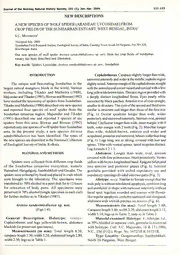
A new species of wolf spider (Araneae: Lycosidae) from crop fields of the Sundarban estuary, West Bengal, India PDF
Preview A new species of wolf spider (Araneae: Lycosidae) from crop fields of the Sundarban estuary, West Bengal, India
. Journal of the Bombay Natural History Society, 101 (1), Jan.-Apr. 2004 121-123 NEW DESCRIPTIONS ANEW SPECIES OF WOLF SPIDER(ARANEAE: LYCOSIDAE) FROM CROP FIELDS OFTHE SUNDARBAN ESTUARY, WESTBENGAL, INDIA1 S.C. Majumder2 'Accepted July, 2001 2SundarbanFieldResearchStation,ZoologicalSurveyofIndia,CanningTown, South24Parganas,Pin743 329, WestBengal, India. One new species of wolf spider Arctosa sandeshkhaliensis sp. nov. from the crop fields of Sundarban estuary has been described and illustrated. Key words: Spiders, Lycosidae,Arctosasandeshkhaliensis sp. nov., Sundarban INTRODUCTION Cephalothorax:Carapaceslightlylongerthanwide, narrowedanteriorlyandwideratthemiddle;cephalicregion The unique and fascinating Sundarban is the slightlyraised.Anteriormarginofthecephalothoraxstraight largest natural mangrove block in the world. Various withtheanterolateralcornerraisedandconical withafew workers, including Tikader and Malhotra (1980), longyellowish-brownhairs.Thoracicregionprovidedwith MajumderandTikader(1991),BiswasandBiswas(1992) a deeply distinct longitudinal fovea. Eyes pearly white have studied thetaxonomyofspidersfrom Sundarban. encircledby blackpatches. Anteriorrowofeyesstraight, Tikaderand Malhotra(1980)described onenewspecies smallerinstructure.Theeyesofthesecondandthirdrows and reported four species of wolf spider from the similar in structure and largerthan those ofthe first row Sundarban estuarine region. Majumder and Tikader (Fig. 1). Ocular quadrate longer than wide; wider (1991) described one and reported 3 species of sac posteriorlyandnarrowedanteriorly. Sternumoval,pointed spiders from this area. Biswas and Biswas (1992) behind. Chelicerae longerthan wide, innermargin with 4 reportedonlyonespeciesofwolfspiderfrom Sundarban teeth, outer margin with 2 teeth (Fig. 2). Maxillae longer area. In the present study, a new species Arctosa than wide, reddish-brown, anterior end wider and sandeshkhaliensis has been identified. The types of scopulated,posteriorendnarrowed,labiumwiderthan long thenew speciesaredeposited in theNational Collection (Fig. 3). Legs long, not so strong, covered with hair and ofZoological Survey ofIndia, Kolkata. spines. Tibiawith ventral spines;tarsal scopulaedistinct. Legformula4 2 13. MATERIALANDMETHODS Abdomen: Longer than wide, oval, dorsum coveredwith fine pubescence, bluntposteriorly. Venter Spiders were collected from different crop fields yellowwithbrown longitudinalband. Epigynebifurcated of the Sundarban estuarine ecosystem, namely into anterior and posterior plates (Fig. 4). Internal Hasnabad, Hengalgunj, Sandeshkhali and Gosaba. The genitalia provided with coiled copulatory sac and spiderswerecollectedbyhandandplaced invialswhich copulatoryopeningsdivided intotwoparts(Fig. 5). were brought to the laboratory. The specimens were Allotype: male: Similarto female exceptthatthe transferredto 70%alcohol in apetri dish for6-12 hours malepalp iswithoutretrolateralapophysis,cymbiumlong for relaxation of body parts. All specimens were and semilunarinshapewithnarroweranteriorlywithout preserved in 70% alcohol (singlespecimen in each vial) basal spur, tegulum rounded and convex with flower- forfurtherstudies as in Tikader(1987). likeregularapophysis,embolusnarrowedandelongated, abdomen with whitish patcheson dorsum (Fig. 6). Arctosa sandeshkhaliensis sp. nov. Measurements (in mm): Total length 5.60, (Figs 1-6) Carapace length 3.40,width 2.20,abdomen length 3.15, width 2.10, legs as in Table 2, palp as in Table 3. General Description: Holotype: female: Materialexamined: Holotype: 9,Allotype: Id1 , Cephalothorax and legs yellowish-brown, abdomen in 70% Alcohol in separatevials, genitalia inmicrovial blackish (in preserved specimens). with holotype. Coll. S.C. Majumder, 16 & 17.i.1994, Measurements (in mm): Total length 6.30, N.C., ZSI (H.Q.), Regn. No. 5472/18 & 5473/18. carapace length 3.50,width3.20,abdominal length2.80, Type Locality: Durgamandap, Sandeshkhali, width 2.50, legsas in Table 1 North 24 Parganas, West Bengal. NEW DESCRIPTIONS Figs 1-6: Arctosa sandeshkhaliensis sp. nov., 1. Dorsal view offemale, legs omitted, 2. Chelicera showing arrangement ofteeth, 3. Maxillae and labium, ventral aspect, 4. Epigyne, ventral aspect, 5. Internal genitalia, dorsal aspect, 6. Male palp, lateral aspect Table 1: Measurements (in mm) of leg segments ofArctosa sandeshkhaliensis sp. nov. (Female) Leg Femur Patella & Tibia Metatarsus Tarsus Total 2.10/2.10 2.80/2.80 2.00/2.00 1.10/1.10 8.00 1 2.80/2.80 3.10/3.10 1.20/1.20 1.15/1.15 8.25 II III 1.80/1.80 2.50/2.50 1.90/1.90 1.05/1.05 7.25 IV 3.10/3.10 3.50/3.50 2.30/2.30 1.30/1.30 10.20 Distribution: Sundarban areas (Sandeshkhali, A. khudiensisTikaderand Malhotracephalothoraxmore North 24 Parganas), West Bengal, India. or less parallel sided and not wider at the middle, Discussion: This species resembles Arctosa abdomen not bluntposteriorly. & khudiensisTikader Malhotra in general appearance, 2. The eyes ofthe second row similar in structure butdiffers from it inthefollowingparticulars. with thoseofthethird row,whereas inA. khudiensiseyes 1. Cephalothorax not parallel sided, wider at the ofthe second row largerthan those ofthethird row. middle, abdomen blunt posteriorly, whereas in 3. Epigyne structurallydifferent. 122 J. Bombay Nat. Hist. Soc., 101 (1), Jan.-Apr. 2004 NEW DESCRIPTIONS Table 2: Measurements (in mm) of leg segments ofArctosa sandeshkhaliensis sp. nov. (Male) Leg Femur Patella & Tibia Metatarsus Tarsus Total 2.20/2.20 2.40/2.40 2.05/2.05 1.05/1.05 7.70 1 2.40/2.40 2.60/2.60 2.10/2.10 1.05/1.05 8.15 II 2.10/2.10 2.30/2.30 2 05/2.05 1.05/1.05 7.5 III IV 2.60/2.60 2.90/2.90 2.30/2.30 1.10/1.10 8 90 Table 3: Measurements (in mm) of male palp ofArctosa sandeshkhaliensis sp. nov. Femur Patella Cymbium & tegulum Embolus Total 1.70/1.70 1.20/1.20 2.50/2.50 1.50/1.50 6.90/6.90 Etymology: The species is named after the type in-charge, Sundarban Field Research Station, localitySandeshkhali. Canning, West Bengal for kind permission to carry ACKNOWLEDGEMENTS out the work and also Dr. B.K. Biswas Scientist SE&Officer-in-charge, ArachnidaStation, Zoological I thank Dr. J.R.B. Alfred, Director, Zoological Survey of India, Kolkata for confirming the new SurveyofIndia,Kolkataand Shri K.N. Reddy, Officer- species. REFER N C E S Biswas,B.K.&K. Biswas (1992): FaunaofWestBengal:Araneae, Occ. Pap. 102: 1-175. Spiders.StateFauna,Series,FaunaofWestBengal.Zoological Tikader, B.K. (1987): Handbook of Indian Spiders. Zoological SocietyofIndia3(3): 357-500. Survey ofIndia. Pp. 1-251. Majumder,S.C.&B.K.Tikader(1991):Studiesonsomespidersof Tikader, B.K. & M.S. Malhotra (1980): FaunaofIndia. Spiders the Family Clubonidae from India. Rec. zool. Surv. India, (Lycosidae).2(2):259-446. J. Bombay Nat. Hist. Soc., 101 (1), Jan.-Apr. 2004 123
